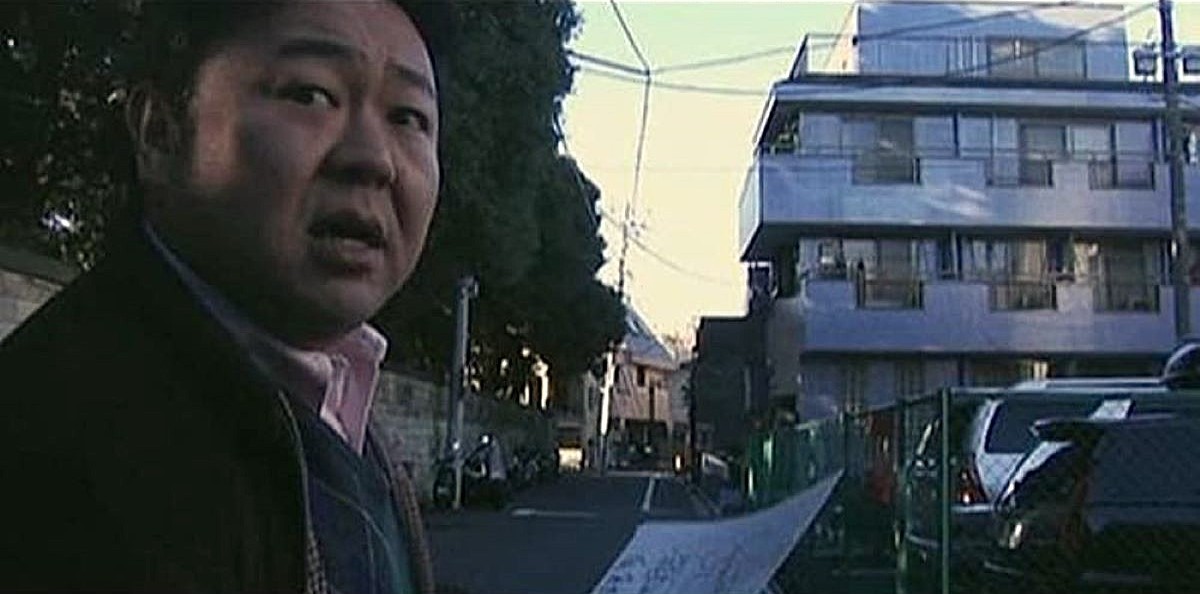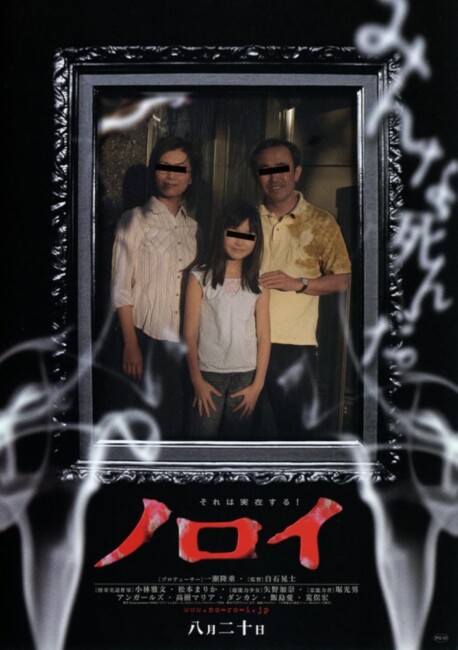(Noroi)
Japan 2005.
Crew
Director – Koji Shiraishi, Screenplay – Koji Shiraishi & Naoyuki Yokota, Photography – Shozo Murashita. Production Company – EF/Geneon/Oz/Xanadeux/PPM.
Cast
Jin Muraki (Masafumi Kobayashi), Satoru Inamori (Mitsuo Hori), Marika Matsumoto (Herself), Rio Kanno (Kana Yano), Tomona Kuga (Junko Ishii), Yoko Chosokabe (Kimiko Yano), Miyoko Hanai (Keiko Kobayashi), Makoto Inamori (Koichi Hirotsu), Takashi Kakizawa (Shinichi Osawa), Maria Takagi (Herself)
Plot
A box of videotapes is sent to a magazine from the paranormal investigator Masafumi Kobayashi, who has gone missing. Masafumi was investigating a variety of paranormal incidences – a woman Junko Ishii who is reported by a neighbour as having the sounds of children crying coming from her house; Kana Yano, a young girl who appeared on a tv show and demonstrated great clairvoyant abilities before going missing; Marika Matsumoto, a psychic who was investigating a haunted temple with several others; and Mitsuo Hori, a tin foil hat psychic who believes in ectoplasmic worms. As Masafumi investigated, he discovered deeper connections between these incidents.
Noroi: The Curse was a film made early into the Found Footage fad. The Blair Witch Project (1999) created a phenomenon and patented the grainy handheld video look supposedly being shot by amateur filmmakers in the midst of supernatural action. It saw a number of imitators over the next few years, before the huge hit of Paranormal Activity (2007) in 2009. (For a more detailed overview see Found Footage Films).
It is important to put Noroi: The Curse in context – it came out a full four years before Paranormal Activity caused the Found Footage film to explode massively after which films about people investigating haunted phenomena with video cameras became commonplace. It was among a small handful of Blair Witch imitators being made throughout the 2000s. As such, it reuses Blair Witch’s basic Paranormal Investigators theme – it is not too difficult to substitute Jin Muraki’s character here roaming the streets of Tokyo with a camera for the three students lost in the woods in Blair Witch. Certainly, Koji Shiraishi is far more inventive in many regards than Blair Witch directors Daniel Myrick and Eduardo Sanchez in that he winds in mocked up footage from Japanese tv shows as well. The scenes towards the end pursuing people into the woods with cameras does briefly seem to make the Blair Witch homage overt.
The other noticeable thing is that Koji Shiraishi has smartly blended the Found Footage film with the J-horror films (Japanese ghost stories) that was all the rage around the time with the international hits of Ring (1998) and Ju-on: The Grudge (2003) and produced a blend of the two. The scenes with the woman next door (Tomona Kuga) and her ghostly son definitely have something of the Ju-on films to them, while in the most direct inspiration she starts making unearthly croaking noises at one point. Not to mention that the film also explains that a ‘noroi’ is a curse, just like a ‘ju-on’ is meant to be.

My main issue with Noroi: The Curse is that it has a very bitsy plot. It feels like a bunch of individual episodes from some YouTube ghost hunter channel strung together – the strange woman neighbour, the clairvoyant girl appearing on tv, the missing girl with great psychic abilities, the crank psychic, the strange man in an apartment building catching pigeons, The plot seems all over the place and you are left confused trying to follow or make any connection between what is going on. To the film’s credit, it brings these unconnected episodes together later in the show.
Koji Shiraishi drags these almost plotless proceedings out for nearly two hours. His pacing during this is far too slow. If you compare Noroi: The Curse to other J-horror films of this period such as the Ring or Ju-on films or any of their imitators, what is crucially lacking here is much in the way of spooky atmosphere. Certainly, the scenes where the film talks about the mystery neighbour woman conducting illegal abortions and taking aborted foetuses home to feed to her son heads into a very dark place – shades of the then recent Dumplings (2004) – as do the images of the seven people having hung themselves on children’s swings in a park – shades of the then recent Suicide Club (2002). However, all of this takes place off-screen – at most we get the image of the hanged bodies on a tv news report.
Director Koji Shiraishi is a regular director of J-horror films, having also made the likes of Ju-rei: The Uncanny (2004), Carved: The Slit Mouthed Woman (2007), Yurei Zombie (2007), Grotesque (2009), Occult (2009), Teketeke (2009), Teketeke 2 (2009), Shirome (2010), Ada Part 1 (2013), Ada Part 2 (2013), Cult (2013), A Record of Sweet Murderer (2014), Sadako vs Kayako (2016) and Hell Girl (2019).
Trailer here


